Plane mirrors (A-level physics)

Geometrical optics
Optics is the study of light energy and its properties
Evidences that light is a form of energy
- When light enters our eyes, it enables us to see.
- When light is absorbed by green plants, it enables then to make their food by photosynthesis
- When light is incident on certain materials, the surface electrons acquire energy and escape. This process is called photoelectric emission.
Light rays
The path taken or indicating the direction along which light energy travels is known as a ray of light. A ray is indicated with an arrow.

Beam of light
A group of light is called a beams. There are three types of beams namely

Reflection of light at a plane mirror
Reflection is the bouncing back of light energy when it meets an obstacle
Laws of reflection of light
Consider a ray of light AO incident on a plane surface and then reflected along OB as shown.

O = point of Incidence.
AO = incident ray
OB = reflected ray.
ON = normal to the reflecting surface
<i = angle of incidence
<r = angle of reflection
LAW 1:
The incident ray, the reflected ray, and the normal at the point of incidence all lie in the same plane.
LAW 2:
The angle of incidence is equal to the angle of reflection.
Example 1
State laws of reflection
Types of reflection:
(i).REGULAR REFLECTION: This occurs when a parallel beam of light incident on a smooth surface such as a plane mirror gets reflected as a parallel beam as shown.

(ii). DIFFUSE / IRREGULAR REFLECTION: This occurs when a parallel beam of light incident on a rough surface such as a paper gets reflected while scattered in different directions as shown

Differences between regular and irregular reflection
| Regular reflection | Irregular reflection |
| Occurs on smooth surface | Occurs on a rough surface |
| Parallel incident beam is reflected parallel | Parallel incident beam is scattered after reflection |
| Reflected beam is very bright | Reflected beam is dull |
Deviation of light at plane mirror surfaces
This is the property of a plane mirror to deviate incident light from its original direction to another.
Let g be the glancing angle made by the ray AO with the mirror M1M as shown
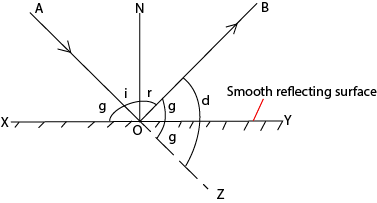
d = ZOB = angle ZOY + angle BOY
Angle ZOY = g (opposite angles)
d = g + YOB
but d = g + (90-r)
but r =i (laws of reflection)
therefore, d = (90 – i)
d = g + g (since g = 90 –i)
d = 2g
Hence, the angle of deviation of a ray by a plane surface is twice the glancing angle
Example 2
Prove that a ray incidence on a plane mirror, d = 2g. where d is the deviation and g is the glancing angle.
DEVIATION OF REFLECTED RAY BY ROTATED MIRROR
Let XY be the initial position of the mirror with ray AO making a glancing angle g. By keeping the direction of the incident ray fixed, the mirror is rotated through an angle α to a new position X’Y’ as shown.
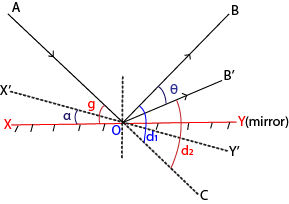
Case 1 (mirror in position XY)
Glancing angle = g
Deviation d1 = 2g……… (i)
Case 2(mirror in position X’Y’)
Glancing angle = (g – α)
Deviation d2 = 2(g – α) …..(ii)
θ = d1 –d2
= 2g – 2(g – α)
= 2g-2g + 2α
= 2α
Hence, if the direction of incident ray is constant, a reflected ray rotates through an angle = 2α, when the mirror is rotated through an angle α.
This is applied in optical lever in mirror galvanometer where a beam of light serves as a pointer.
Advantages of optical lever to metallic pointer
- Its weight is negligible hence highly sensitive
- Magnifies the angle of rotation.
- Can be used to measure very small electric current and small changes in length due to expansion and contraction of solid.
Action of optical lever
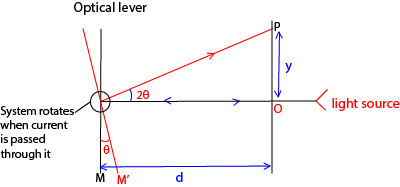
- A beam of light from the light source is normal to the mirror and is reflected back through the same direction at O
- Current through the galvanometer causes the coil to rotate the mirror through an angle θ to position M’ and the beam of light is reflected through angle 2θ and deflected to position P by displacement y.
Example 3
- Describe briefly the action of optical lever.
- An optical galvanometer of sensitivity 0.05 radian per M.A is used to measure current of 0.2A. the distance of the cell from the linear scale is 30cm. Find the displacement of light spot on the scale from the initial position.
Solution
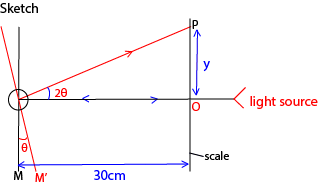
3600 = 2π radian
1MA of current through the coil turns the mirror through an angle 0.05radian
It implies that, 0.02MA turns the mirror through 0.05 x 0.2 = 0.01radians
The reflected ray turns through 2θ= 2 x 0.01 = 0.02 radians
But tan2θ = y/30
tan 0.02 = y/30; y = 0.6cm
Deviation by successive reflections at two inclined mirrors
Consider an incident ray of light reflected successively from two mirrors M1 and M2 inclined at an angle q to each other at O as shown

Let the glancing angles at A and B be a and b respectively. Deviation by M1 = 2a ( clockwise direction )
Deviation by M2 = 2b ( clockwise direction ) Total deviation = 2a + 2b
= 2 ( a + b ) ———————-(i)
But, a + b + θ = 180° ( Angle sum of a triangle )
a + b = ( 180° – θ ) ———————(ii)
Combining equation ( i ) and (ii) gives
Total deviation = 2 ( 180° – θ ) ( clockwise direction )
= 360° – 2θ (clockwise direction)
= 2 θ (anti-clockwise direction)
Thus, the deviation produced by two inclined mirrors is twice the angle between the mirrors when a ray under goes two successive reflections.
NOTE
(i) Clock wise deviation (360° – 2θ ) + anti-clockwise deviation (2θ) = 360°
(ii) The above result finds application in the sextant, a device for measuring the angle of elevation of the sun or stars.
The sextant
A sextant is an instrument used in navigation for measuring the angle elevation of the sun or stars or the angle between two objects in space. It works on the principle of two inclined mirrors. The estimation of this angle, is known is sighting or shooting the object, or taking a sight.
Principle of a Sextant
The principle of a sextant is that, when the ray of light is reflected from two mirrors in succession in the same plane, then the angle between the incident and reflected ray is two times the angle between the mirrors.

-
- A sextant consists of a fully silvered mirror M1which can be rotated about a horizontal axis and a fixed half silvered mirror B.
- Mirror M1 is adjusted to become parallel to Bby rotating it until the image of the horizon, H’ is seen directly through the unsilvered part of mirror B by successive reflection in mirror M1 and B respectively
- The mirror M1 is rotated to position M2 such that the image of the horizon H, and the sun coincides at H’
- The angle of rotation is measured from the scale on the instrument. The elevation of the sun is 2θ.
Example 4
Describe briefly how the elevation of the sun can be determined using the principle of the sextant or briefly describe the operation of the sextant.
Image formation in plane mirrors
Consider an object A placed in front of a mirror M.
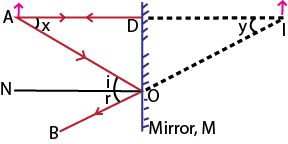
A ray AD from A incident normally on the mirror at D is reflected back along DA.
The Ray AO is reflected along OB and appears to come from point I behind the mirror.
The intersection I of the rays AD and BO is the image position.
From above angles,
x = i (alternating angles)
i = r (2nd law of reflection)
r = y (corresponding angles)
Combining all the equations gives
x = i = r = y
Þ angle x = angle y
Tan x = tan y
DO\ AD = DO/DI
Thus AD = ID.
\The image is as far behind the mirror as the object is in front
CHARACTERISTICS OF IMAGES FORMED BY PLANE MIRRORS
It is virtual
It is erect
It is laterally inverted
It is of the same size as the object
It is as far behind the mirror as the object is in front
Uses of plane mirrors
- Dressing mirrors
- In telescope
- In periscopes
Number of images formed by two plane mirror inclined at an angle
Two plane mirrors inclined at an angle θ to each other. The number of images formed is given by the formula
n = (360 /θ) -1
Example 4
What is the number of images formed between two mirrors inclined at 600 to each other? (5)
IMAGE LOCATION BY NO PARALLAX

An object pin O is placed in front of a plane mirror to form a virtual image I.
A large search pin P is placed behind the mirror and moved to such a position that there is no parallax between pin P2 and the image I.
The image position has therefore been located.
NOTE
Parallax is the perceived change in position of an object seen from two different places
No parallax method of locating an image involves an image coinciding in position
with a search pin such that when the observer’s head is moved sideways, both the image and the search pin appear to move in the same direction. This is when there is no relative motion between them.
Example:
1. A man 2m tall whose eye level is 1×84m above the ground looks at his image in a Vertical mirror. What must be the minimum vertical length of the mirror so that the man can see the whole of himself completely in the mirror ?
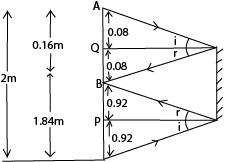
Rays from the top of the man are reflected from the top of the mirror and are incident
in the man’s eyes (point B is the man’s eye level)
Since AQ = BQ then, BQ = 1 ´ 0×16 = 0×08m
2
Similarly BP = PC. Thus BP = 1 ´ 1×84 = 0×92m
2
The minimum length of the mirror = BQ + BP
= 0×08 + 0×92
= 1m
Comparision of plane mirrors and reflecting prisms.
(i) Un like in prisms, plane mirrors produce multiple images
(ii) The silvering in plane mirrors wears out with time while no silvering is required in prisms
(iii)Unlike in prisms, plane mirrors exercise loss of brightness when reflection occurs at its surface.
Formation of multiple images in a thick plane mirror
When an object is observed through a thick mirror, silvered at its back, a large number of images are obtained.
Out of all the images, the second image is the brightest because the first image is formed by reflection at the first unsilvered surface, while the second image is formed by reflection by the silvered surface. Then others by multiple internal reflection inside the glass.
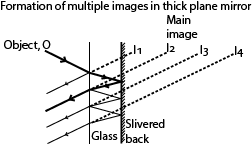
EXERCISE
1. What is meant by reflection of light?
2. State the laws of reflection of light
3. Distinguish between regular and diffuse reflection of light
4. Show with the aid of a ray diagram that when a ray of light is incident on a plane mirror, the angle of deviation of a ray by the plane surface is twice the glancing angle.
5. Derive the relation between the angle of rotation of a plane mirror and the angle of deflection of a reflected ray, when the direction of the incident ray is constant.
7. (i) Show that an incident ray of light reflected successively from two mirrors inclined at an angle q to each other is deviated through an angle 2q.
(ii) Name one application of the result in 7(i) above.
8. Describe how a sextant is used to determine the angle of elevation of a star.
9. Show that the image formed in a plane mirror is as far behind the mirror as the object is in front
10. State the characteristics of images formed by plane mirrors.
11.(i) What is meant by No parallax method as applied to location of an image? (ii) Describe how the position of an image in a plane mirror can be located
12. Show that for a man of height, H, standing upright the minimum length of a vertical plane mirror in which he can see the whole of himself completely is H/2
13 With the aid of a ray diagram, explain how a thick plane mirror forms multiple
images of an object.
14. Give three reasons for using prisms rather than plane mirrors in reflecting optical instruments.
Please download PDF
Sponsored by The science Foundation College +256 753 80 27 09
Compiled by Dr. Bbosa Science
Thanks

Sir I’ve gained much from this work thanks
It’s really helpful. Thanks so much
Add more nots they are so summerised
Thanks for being a beacon of knowledge. Toys & Games
You have a gift for explaining things clearly. 500 ka redeem code
Discover the latest updates on the MBBS Cutoff Of Private Medical Colleges in Punjab for seamless admissions.
Secure a medical career with MBBS Admission Through Management/Nri Quota in Karnataka.